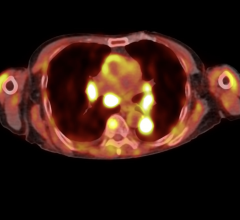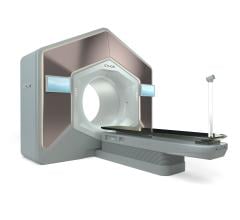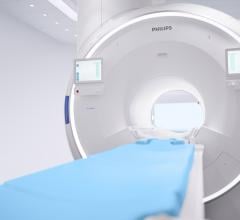One of the primary goals of radiation therapy of the prostate is maximizing dose delivery to the actual cancerous tissue and minimizing radiation exposure to healthy tissue and to insure that the cancer is continuously hit throughout treatment.
However, precision of treatment in prostate cancer is especially challenging due to the location of the prostate situated in such close proximity to the bladder and the rectum and the tendency for the prostate to move. Yet new approaches to radiation therapy, such as cone-beam imaging, proton therapy and novel radiopharmaceuticals, are giving physicians a clearer view of how to effectively treat prostate cancer.
GPS for the Body
One such image-guided radiation therapy (IGRT) system, commonly referred to as the “GPS for the Body,” is the Calypso System, designed to provide clinicians with a non-ionizing means to efficiently and objectively measure and monitor organ motion during radiation therapy. It provides continuous real-time tracking identification of implanted Beacon transponders and is used to both set-up and perform tracking of the target organ throughout external beam radiation therapy.
Nearly five years ago, Howard Sandler, M.D., professor of radiation oncology and senior associate chair of radiation oncology at the University of Michigan, participated in the initial clinical trials using the system.
Commenting on how Calypso has impacted his treatment delivery, he said, “The main advantage is it allows me to be more secure at treating prostate cancer everyday because it allows for continuous tracking of the prostate throughout the treatment. I know the prostate can move unexpectedly during treatment and if the prostate moves out of focus of my treatment beam, then I am under-dosing prostate cancer during those seconds when the prostate is out of my field. With Calypso, we know when that happens instantly and can reposition the field or the patient and make sure that none of our rads are wasted.”
In addition to greater confidence in treating the target, the Calypso system has also expedited patient throughput, according to Dr. Sandler, because of its ability to align patients so quickly prior to the start of treatment. In terms of side-effect reduction, Dr. Sandler has not observed a marked difference. He explained that theoretically the extra precision with the Calypso would decrease the amount of tissue exposed to radiation, which would in turn equate to better tolerated treatments. However, a clinical study has not yet been done to demonstrate its efficacy as it relates to side-effect reduction.
Cone Beam Lowers the Dose
Another IGRT system making a breakthrough in prostate cancer radiation therapy is Siemens’ MVision Megavoltage Cone Beam Imaging Package, which reduces the entire process of acquisition, reconstruction and registration to less than three minutes for patient positioning with a one-step click of a button. Guillaume Grousset, director of marketing, oncology care systems for Siemens Medical Solutions USA explained, “When [implants are used], MVision allows for extremely low-dose imaging and when I say low dose imaging I mean anywhere between one and three centigrade. One of the very interesting things with MVision is the same radiation we use for treatment, we use for imaging. We account for the dose used for imaging in the treatment plan.”
In addition to low-dose imaging, MVision imaging also enables exceptional image acquisition in patients who may have metallic objects near the field of vision as a result of, for example, a hip replacement. In these instances, the MVision does not create any artifacts in the image even in challenging patients, according to Grousset. The MVision is also well-fitted to accommodate large patients.
Grousset said, “Traditional kilovoltage imaging is not always powerful enough to go through large patients. You may end up doing a couple of rotations around the patient to acquire enough data to reconstruct your volumetric image and the big question mark is what is the dose to the patient. Because we use the treatment beam and it is the same energy we use to treat those patients, we don’t have that problem at all even with fairly large patients.” Low dosing to reduce side effects and quality image acquisition are the hallmarks of the new MVision technology.
Divvy Up the Dose
Although IGRT has made significant advancements in the field of radiation therapy treating prostate cancer, challenges still exist with accuracy. Because the nature of prostate cancer is multifocal and arises simultaneously in numerous areas, one expert in the field poses the question, “Does it makes sense to treat the entire gland with the same dose of radiation?” Adam P. Dicker, M.D., professor and interim chairman of the department of radiation oncology at Jefferson Medical College at Thomas Jefferson University in Philadelphia, PA, and leader of the radiation research and translational biology program at the Kimmel Cancer Center at Thomas Jefferson University Hospital, is a leading expert in the field of IGRT for prostate cancer and recently edited the book, “Image Guided Radiation Therapy of the Prostate.”
He explained that regardless of the definitive treatment, whether it be surgery, radiation therapy or cryotherapy, the whole gland ends up being treated with the same dose of radiation. However, he discussed a new technology, proton therapy, being used in a few cancer centers currently that may allow treating the whole gland while delivering a higher dose of image-guided treatment to certain areas of the gland.
“Theoretically protons should allow you to have less normal tissue treated because you can define the borders of the prostate and you can define where the beam is going to enter and where it is going to stop and your normal tissue should have minimal toxicity,” Dr. Dicker said. The only drawback with proton therapy is that it does not take into account organ motion. He explained, “They can’t right now modulate the beam and you can’t craft and shape the beam to the same level of precision that you can with photons. There is not a shred of data at the moment that supports the fact that there is a clinical benefit to protons. Protons will reduce toxicity, but there’s not a shred of data that supports that.” His hope is that cancer centers that use proton therapy participate in a clinical trial to gather more data on the benefits of proton therapy versus the more commonly used photon therapy techniques.
When asked about which image-guided treatment excels above the rest, he explained that the data thus far is not very conclusive. According to Dr. Dicker, “The issues really are quality of life issues and what the [patients] perceive.” With each treatment technique comes its own set of trade-offs. For example, IMRT is administered over eight weeks, while seed implants take one visit to the clinic but require anesthesia. Radiation also has a tendency to cause more urinary side effects, while surgery may cause more sexual dysfunction. If a patient wants more immediate gratification, surgery will cause PSA levels to decrease to zero in three months whereas with radiation, a decline should occur within six months to a year or longer, according to Dr. Dicker. “So, quality of life issues really transcend everything,” he concluded.
Novel Radiopharmaceuticals
While numerous options exist for the treatment of prostate cancer, new techniques in radiation therapy promise even greater toxicity reduction and improved prostate cancer treatment.
Several new radiopharmaceutical advancements are underway to better treat, detect, stage and prevent the recurrence of prostate cancer.
UCLA researchers led by Lily Wu demonstrated how positron emission tomography (PET) located diseased cells as they metastasize to lymph nodes when used with a genetically engineered common cold virus that attaches to prostate cancer cells, which is the first place prostate cancer goes before invading other organs. These results provide hope for finding the spread of cancer earlier by being able to visualize its spread, which is currently difficult using conventional means. Wu hopes to take this finding one step further by adding a treatment component to the genetic payload, which could kill the cancer as it spreads.
Other strides are being made in the early detection and staging of prostate cancer by Molecular Insight Pharmaceuticals Inc. which has initiated a Phase I clinical trial for Trofex, its molecular imaging program. The trial is designed to investigate two small molecule radiopharmaceutical candidates that target prostate cancer.
In another study researchers found that a new drug by Apthera, NeuVax (E75), delays the recurrence of prostate cancer in terms of prostate specific antigen levels and clinical recurrences in men who were HER2 positive for prostate cancer. Findings demonstrated that the median time to recurrence for the treatment group was 14 months compared to 8.5 months for the control group. This data is now sufficient to warrant a larger, randomized Phase II trial for the efficacy of NeuVax.
These recent advances in radiation therapy (RT) and disease diagnosis show tremendous potential in better locating and targeting prostate cancer pre- and post-metastasis.
Feature | September 02, 2008 | Amy Ballard, MEd, director of research,
Cone beam imaging, proton therapy and radiopharmaceuticals hone in on prostate cancer.
© Copyright Wainscot Media. All Rights Reserved.
Subscribe Now


 December 02, 2025
December 02, 2025 









